SECONDARY EDUCATION
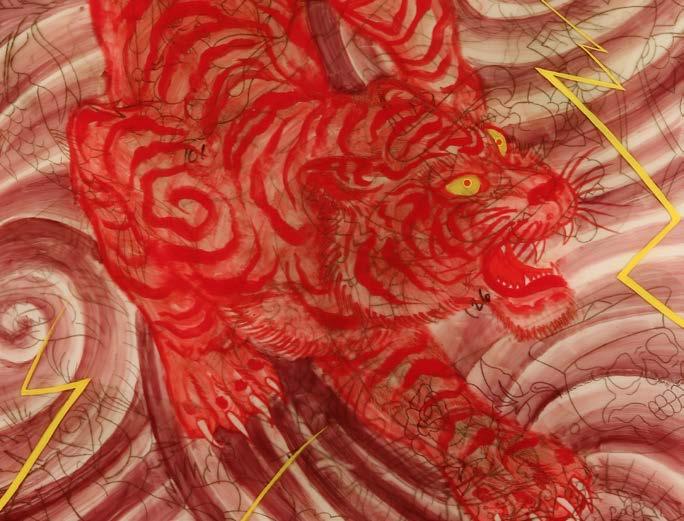
A Permanent Mark: the impact of tattoo culture on contemporary art is supported by the Queensland Government through Arts Queensland
Cover image: Don Ed Hardy

Red Tiger [detail] 2006
Research towards A Permanent Mark: the impact of tattoo culture on contemporary art has been supported through the Darling Travel Grants | Domestic, administered by the Gordon Darling Foundation
Oil paint, etching, and digital printing layered in resin on mounted board
129.54 x 106.68 cm
Courtesy of the Artist, Don Ed Hardy
PINNACLES GALLERY 19 JUNE - 16 AUGUST 2015 the impact of tattoo culture on contemporary art
With the dramatic rise in the popularity of tattooing, the practice has shifted from a ‘fringe’ activity to a broadly accepted body adornment in Western cultures. Getting ‘inked’ has ceased to be only thought of as a visual marker for bikies, criminals and alternate types, with people young and old now sporting tattoos in ever-increasing varieties and complexities. Tattoos have crossed over into a mass-consumer level of acceptance and with this have also started to feature more frequently in contemporary art.
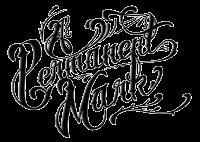
A Permanent Mark: the impact of tattoo culture on contemporary art is an exhibition that looks at how the contemporary art world and tattoo culture overlap. It examines how artists, some of whom are tattoo artists, have used tattoos as inspiration in their art or have used tattoos as an art form.
This activity book is designed to assist you to explore some of the concepts and artworks in this exhibition. The four symbols below will tell you what to do in each activity:
CREATE WRITE LOOK THINK
4
Key Terms
Inked: being tattooed or having a tattoo
Contemporary art: art that is happening now
Visual language: communicating using imagery or symbols
Juxtaposition: different things placed together to create a new meaning
Device: a visual language in artwork to construct meaning such as humour, repetition, juxtaposition and appropriation, etc.
Repetition: a device used in art. Repeating something to give new meaning
Hatching, cross-hatching and stippling: ways of using line to show tone (light and dark)
Neo-Pop: a postmodern Pop Art movement. Famous artists include Jeff Koons, and Gilbert and George
Pop Art: an art movement starting in the mid-1950s that explored pop culture, advertising, consumerism and commercialism
Still life: an artwork that features only inanimate objects like clocks, skulls and food
Vanitas: a still life painting that tells an allegory (story)
Dia de los Muertos: (the Day of the Dead), is a Mexican celebration to pray and remember those who have departed Blue collar: usually referring to the type of job someone has such as mechanic, truck driver or hair dresser. A job where you don’t wear a suit and tie or work in an office
Cultural identifiers: fashion, music taste, food choices and career that identifies your social class/place of origin
Quintessential: the perfect example of a concept or thing
Moniker: another name that a person goes by
Impermanence: something that doesn’t last
Consumerism: a sociological concept about the acquisition of consumer goods
Commercialism: the act of making profit through the marketing and consumption of goods to/by people
Gigantism: in art terms, enlarging something to give new meaning. Commonly used as a Pop Art device
5
Dr Lakra
Look at Dr Lakra’s work Untitled (Ladies), which pictures beautiful women with traditional cultural facial tattoos that question the definition of ‘real’ beauty. The facial tattoos look very out of place in these pictures but are a symbol of female rank and identity in a number of indigenous and tribal cultures. The artist is using juxtaposition as a device. Juxtaposition is when two different things are used together to create new meaning.
In Dr Lakra’s artwork he places two contrasting ideas of feminine beauty from different cultures together to prompt the viewer to consider their own understanding of the concept. He also encourages us to think about tattoos as fashion by using 1950’s fashion magazines as a canvas for tattoo art.
Image: Dr. Lakra
Untitled (Ladies) 2013-2014
Watercolour on vintage magazine, Set of 5: 26.2 x 22.5 cm each. DL9051 Courtesy of the artist and kurimanzutto, Mexico City

6
Does this artwork make you re-examine your understanding of ‘beauty’? What is the contemporary view of beauty? Do you agree with this understanding? Why/why not?
Different cultures have different understandings about what is ‘beautiful’. Think about another culture you know about and explain some of the things they find beautiful.
Imagine you had to explain your concept of what ‘Australian beauty’ is to a person from a different culture. What would your key points be?
What issue do you feel strongly about? What imagery/text would you juxtapose to visually communicate your message?
7
e de Medici
eX de Medici is an artist whose practice incorporates performance, installation art, tattooing, photography, painting and drawing. de Medici is probably best known for her intricate, largescale watercolours that reference a contemporary slant on the vanitas still life tradition.
In her work, she combines tattooing and fine art techniques and often incorporates recurring motifs such as skulls, guns, insects and swastikas. Gun(n)s ‘n Styx is an example of de Medici’s intricately-layered style and features a visually overbearing array of military-grade weapons and insects in a bed of red and green foliage.

Image: eX de Medici
Gun(n)s ‘n Styx 2005
Watercolour on Paper, 114cm x 178.6 cm
Collection of the artist © eX de Medici
Identify two objects within the composition that are not guns?
8
Still Life
Vanitas still life artworks incorporate objects that have a hidden meaning; a watch or hourglass can mean that life is fleeting, i.e. time’s up.
What could the guns and insects symbolise in de Medici’s artwork? Explain your answer.
Book: knowledge Shell: vanity and wealth
Mirror: transience of beauty
Skull: death Hourglass: time being limited
Flowers/insects: transience of life
Which hidden meaning surprised you most? Why?
9
Rob Douma
Douma is a Townsville-based artist who paints and sculpts dark and brooding surreal and stylised images. Douma is himself heavily tattooed, and skulls - synonymous with both tattoo culture and the Mexican holiday Dia de los Muertos - form an integral part of his visual language.
Often the focal point in his large, vibrantly coloured paintings, Douma has also taken to creating ornamental and functional skull replicas. The skull sculptures have been produced both with the intent of being art objects, and as candle holders, ash trays, and business card holders. The skulls are finely decorated with anchors, spider webs, crosses, floral designs, script, cherry blossoms and oriental designs, and other symbols in a manner which mimics the tattoo process.
Image: Rob Douma Society, Ink. [detail] 2015 Acrylic on cement skulls, 120 x 120 x 16 cm Courtesy of the Artist, Rob Douma
Photograph: Shane Fitzgerald

10
Skull Skins
Using this skull as a base, create your own Douma-inspired skull design. Incorporate decorative symbols such as flowers, vines and crosses.
11
Don EdHardy
Don Ed Hardy is perhaps the biggest name in the tattooing world today, a status that was heightened by the 2004 launch of the international fashion label Ed Hardy, which featured the artist’s iconic Japanese-influenced tattoo illustration style. Here is an example of his artwork, Red Tiger.
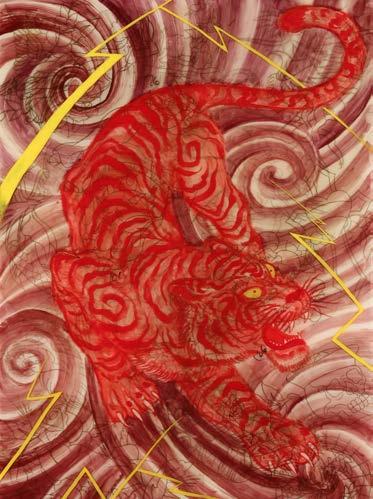
12
Image: Don Ed Hardy Red Tiger 2006
Oil paint, etching, and digital printing layered in resin on mounted board, 129.5 x 106.6 cm Courtesy of the Artist, Don Ed Hardy
Symbolism & Meaning
Look at Red Tiger. Besides the obvious subject of the tiger, you can also see that there are many outlines of other tattoo designs in the background. There are love hearts, skulls, devils, fish and a dragon among others. Tattoos often use symbolism to portray a meaning. For example, an anchor commonly symbolises security and stability in your life, just as they stabilise and secure boats.
Match the symbols to their meanings:
Death/Bravery
Love/Commitment/Forever
Security/Stability
Luck/Chance/Risk
Returning Home/ Hope/Opportunity
13
Ron McBurnie
Look at McBurnie’s work, He tattooed the names of each of his ten wives onto his right arm. The subject matter is gritty and humorous.
An unshaven, blue-collar man leaves a truck stop rolling up his sleeve to display his marital history, tattooed on his upper right arm. A series of names are crossed out. Tracy, his current wife, presumably sits in the background inside the building titled “Trev’s Trucking”.
The subject matter speaks to a quintessential working class life referencing cultural identifiers such as tattoo style, clothing, and career choice.
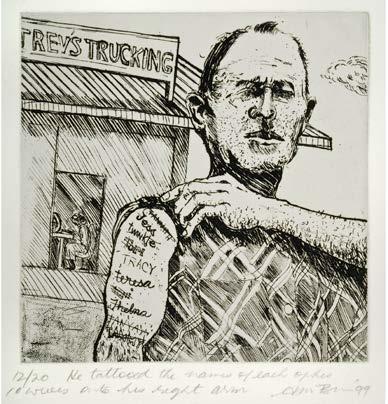
14
Image: Ron McBurnie
He tattooed the names of each of his ten wives onto his right arm 1999 Etching. From the artist book A to Z from my toes to my head by Ron McBurnie and Juli Haas, a folio of 27 etchings. Edition of 20. 15 x 15 cm Courtesy of the Artist, Ron McBurnie
Photo: Michael Marzik
Line
The artwork itself is an etching. Etchings are prints where a line is incised in a metal plate, etched with acid, inked up and then printed on paper with a printing press. McBurnie has used line to create the image, specifically hatching, cross-hatching and stippling. Identify each. In the three lines below, use one of the line styles to create a tonal scale (from dark to light) to cross out one of the ex-wives’ names.
15
Twinkle Tammy Tanya
Amanda Wachob
Wachob has tattooed oranges in this artwork series and then photographed them and printed them as a Type C Print, which means ‘colour print.’

Wachob is both a practicing contemporary artist and also a tattooist. In tattooing fruits, she references the training techniques used by aspiring tattoo artists, whereby they practise tattooing on pieces of fruit and cuts of meat, particularly pig with the skin still attached, before moving on to tattooing people.
Some fruits (and meat) have similar qualities to human skin, and like our skin, they age and deteriorate. In this series, Wachob defies the ageing process by incorporating another medium: photography. In doing so, she juxtaposes the impermanence of the tattooed fruit, which will soon rot, with the frozen moment in time captured by the photograph that will never change.
In the three outlines on the opposite page, use each line style previously learned (stippling, hatching and cross-hatching) to draw and shade the oranges.
16
Image: Amanda Wachob Scratch 5 2012
Type C Photograph of Tattooed Blood Orange, 23 x 16.5 cm Courtesy of the Artist, Amanda Wachob
Line
17
Regan Haha' Tamanui

18
Pop
Regan Tamanui, also known by his street artist moniker, HAHA, is a Melbourne-based artist who uses stencils to create artworks in a colourful, playful Neo-Pop style. In this series, he makes reference to Maori culture and street art. Neo-Pop is a current postmodern manifestation of the earlier Pop Art period that explored pop culture, advertising, consumerism and commercialism; especially the elevating of seemingly meaningless or everyday objects as subjects of art.
Pop Art is arguably best remembered for Andy Warhol’s Campbell’s Soup Cans that used devices such as repetition, colour and gigantism to re-examine the seemingly ordinary soup can.

19
Image previous page: Regan ‘HAHA’ Tamanui Untitled - Tā moko woman #3 2014 Aerosol on 300gsm printmaking paper, 65.1 x 58.6 cm Courtesy of the Artist, Regan ‘HAHA’ Tamanui
Photo: Shane Fitzgerald
Image above and next page: Andy Warhol Campbell’s Soup Cans 1962 Synthetic polymer paint on thirty-two canvases Each canvas 20 x 16” (50.8 x 40.6 cm) Image courtesy of www.moma.org
Contrast
Like Warhol, HAHA uses repetition, a grid composition, colour and contrast in his works. Stencils and spray paint have been used to create the artwork. Each tone in the face requires a new stencil, which simplifies the image and creates contrast that gives the work a flat appearance.
Look at the apple below. Look at the lines. These have been used to decide where the contrast will be. Compare it to Andy Warhol’s Campbell’s Soup Cans.

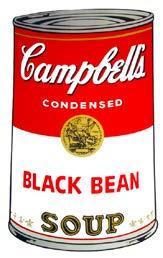
20
Repetition
Think of a consumer product like a soup can or a mobile phone, and draw it. Remember to reduce the object to simple tones to create contrast. In the grid pattern use repetition to draw the same object four times. Colour your work using only one colour with different shades.
21
Reactive Tattoo
Join the dots to reveal the hidden tattoo. Colour and decorate it to make it your own!
22
1 2 3 4 5 6 7 8 9 10 11 12 13 14 15 16 17 18 19 21 22 23 24 25 26 27 28 29 30 31 32 33 34 35 36 37 38 39 40 41 42 43 44 45 46 47 48 49 20
We hope you enjoyed the exhibition and learned lots about contemporary art.
Feedback and Tours
Free guided tours are available. For further information, or to give feedback on education and public programs provided by the Gallery, contact:
(07) 4773 8871
pinnacles@townsville.qld.gov.au
Pinnacles Gallery and Perc Tucker Regional Gallery
Townsville City Council owns and operates two premier regional galleries, Perc Tucker Regional Gallery in the city’s CBD, and Pinnacles Gallery located within the Riverway Arts Centre in Thuringowa Central.
23
24













